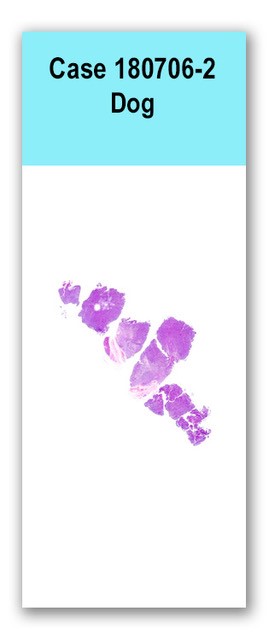Case 2 180706-2 (18B1364)
Conference Coordinator: Dr Melissa Roy.
//
Eleven-month-old, female, intact, Springer spaniel dog
One month prior to biopsy, the patient was presented fo an elevated third eyelid. A tooth root abscess was suspected and a dental was performed, at which point the maxillary molars were determined to be loose and were easily extracted. Blastomyces titers were negative, and the dog was started on antibiotics. One week later, the left mandibular lymph node was enlarged, and a 2-cm-diameter mass appeared over the left temporomandibular joint. Punch biopsies were taken of the mass and lymph node.
The lymph node biopsy consisted of one approximately 1.5 x 1 cm x 1 cm sample of tissue. It was soft, and mottled pale-tan to pink. The mass biopsy was a 0.3-cm-diameter punch biopsy. The surface of the punch was soft and pink, and the remaining 1-cm-long segment was white.
Four variably-sized fragments of a mass and the surrounding fat and fibrous connective tissue are examined. The mass is densely cellular, unencapsulated, and extends to all margins. It is composed of solid sheets and small packets of large round cells separated by thin fibrous septae. Often, cells are arranged in short rows, but remain individualized. Individual cells are round to rarely spindleoid, have distinct cell margins, and contain a moderate amount of eosinophilic cytoplasm. Rarely, there is a perinuclear, homogenous, pale, eosinophilic zone of cytoplasmic clearing, which peripheralizes the nucleus. Nuclei are round to irregularly elongated, or reniform, and contain coarsely stippled chromatin and one to four variably-distinct nucleoli. Rarely, cells contain up to four nuclei. Anisocytosis and anisokaryosis are marked, and there are 166 mitotic figures within ten 400X fields. Individual cell necrosis is common, as well as small focal areas of necrosis. Small numbers of lymphocytes and plasma cells are scattered throughout the mass. Surrounding soft tissues, including a small section of salivary gland, are unremarkable.
An immunohistochemistry stain for desmin revealed diffuse cytoplasmic immunoreactivity among the neoplastic cell populations. The neoplastic cells also had variable nuclear immunoreactivity for myogenin.
Temporomandibular soft tissue: Alveolar rhabdomyosarcoma (solid variant)
Mandibular lymph node: metastatic rhabdomyosarcoma with necrotizing lymphadenitis and perinodal fibrosisRhabdomyosarcomas are uncommon, but tend to affect younger dogs (under 2 years of age). They noften arise from muscles of the head and neck. In humans, rhabdomyosarcomas are categorized as embryonal, alveolar, or pleomorphic histologic subtypes. A subset of the embryonal subtype, botryoid rhabdomyosarcomas, arise along the urogenital crest, most commonly in the bladder. Alveolar subtypes are characterized by poorly-differentiated round cells with scant cytoplasm. They are so called because they arrange themselves into packets separated by fibrous connective tissue. This subtype is further subdivided into classic and solid sub-variants. The classic type is loosely packeted, with thick fibrous septae, while the solid variant forms sheets of round cells which are separated by thin, or sometimes absent fibrous septae. In humans, alveolar subtypes of any variant tend to be more aggressive and have a higher metastatic rate; however there are no well-established prognostic indicators in dogs. The use of immunohistochemistry is useful in differentiating these tumors from other embryonal tumors that may look histologically similar. Myogenin and MyoD1 are two early embryological transcription factors involved in differentiating mesoderm cells into myoblastic cells. They are also involved in myoblastic cell proliferation, and myoblast differentiation into myotubules. When neoplastic cells are less differentiated, they are less likely to express desmin, actin, or myosin. In addition, desmin can also be expressed in other neoplastic cell types, or normal tissue. For these reasons, myogenin is considered a more specific marker for rhabdomyosarcoma. Interestingly, myogenin and MyoD1 have been used to differentiate alveolar and embryonal subtypes in humans, which is useful in determining prognoses. Alveolar subtypes more diffusely have nuclear immunoreactivity to myogenin, and patchy immunoreactivity to MyoD1. Conversely, embryonal subtypes have more sparse immunoreactivity to both myogenin and MyoD1. Such distinctions in immunoreactivity have not yet been described in canine rhabdomyosarcomas. We thank Dr. Kevin Keel for reviewing this case.
Caserto BG. A comparative review of canine and human rhabdomyosarcoma with emphasis on classification and pathogenesis. Veterinary Pathology. 2013; 55(5): 806-826.

